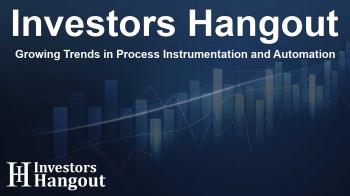Growing Trends in Process Instrumentation and Automation

Trends in Process Instrumentation and Industrial Automation
The Process Instrumentation market is experiencing robust growth, attributed to the increasing demand for industrial automation globally. Recent trends indicate that this sector is projected to reach USD 27.93 billion by 2031, marking a significant increase from USD 19.18 billion in 2024, with an anticipated compound annual growth rate (CAGR) of 5.8% during this period.
What Drives Market Growth?
Several key factors contribute to the accelerated growth of the Process Instrumentation market. As companies scale their operations and expand their geographical reach, there is an amplified need to manage high volumes of processes efficiently. This necessity underscores the adoption of process instrumentation technologies, which support preventive maintenance and enhance operational efficiency.
The Importance of Automation
One of the primary drivers of this market is the rising industrial automation. Companies are increasingly recognizing the benefits it offers, such as reduced capital expenditures and enhanced product quality. By minimizing manual labor, automation speeds up processes and eliminates errors. Notable players in this space include Mitsubishi Electric, Omron Corp., and Rockwell Automation, all of which are innovating and launching advanced automation platforms. For example, Rockwell Automation recently introduced FactoryTalk OptiX, a cloud-enabled human-machine interface (HMI) that empowers users to develop and deploy applications seamlessly.
Impact on the Chemical Industry
Process instrumentation is essential across various sectors, notably the chemical industry. The demand for precise sensors, analyzers, and control systems ensures product quality, compliance with stringent regulations, and optimization of production processes. Investments in this area are fueled by government initiatives that support sectors like pharmaceuticals. For instance, recent policies have accelerated domestic manufacturing and innovation within this field.
Energy Efficiency and Global Trends
As industrialization surges in countries like Brazil, India, and China, energy efficiency becomes a critical focus. Industries, particularly chemicals, oil and gas, and power generation, are significant consumers of energy. The response has been the implementation of national programs aimed at improving energy use across various sectors, reinforced by regulations and energy service corporations.
Geographical Insights
North America currently dominates the Process Instrumentation market, with Europe and the Asia Pacific following. Remarkably, Asia Pacific is projected to exhibit the highest CAGR during the forecast period, underscoring the region's increasing investment in process instrumentation to meet growing energy demands and regulatory standards.
Market Segmentation and Competitive Landscape
The market can be categorized based on technology, including flow meters, pressure and temperature sensors, analytical instruments, and level meters. Among these, analytical instruments are anticipated to witness notable growth. Furthermore, applications of process instrumentation extend to oil and gas, energy and power, water treatment, and food and beverage sectors, among others.
Key Market Players
A number of significant companies are contributing to various developments in the Process Instrumentation market. Key players such as ABB Ltd., Emerson Electric Co., and Honeywell International Inc. continue to innovate and expand their offerings in response to the evolving market demands.
Conclusion: Future Opportunities
The future of the Process Instrumentation market appears promising, particularly as the demand for energy and efficient operational practices rises in the Asia Pacific region. Companies operating in this sector are well-positioned to expand their offerings, aligning with the growing emphasis on sustainable infrastructure and renewable energy initiatives globally. With government backing and a shift towards decarbonization, the prospects for this market are set to grow significantly.
Frequently Asked Questions
1. What is the projected growth of the Process Instrumentation market?
The market is expected to reach USD 27.93 billion by 2031, with a CAGR of 5.8%.
2. What factors drive the growth of this market?
The key drivers include the rise of industrial automation, the need for process efficiency, and governmental support for manufacturing sectors.
3. How is industrial automation impacting the market?
Industrial automation enhances product quality and reduces manual labor, leading to increased adoption of Process Instrumentation technologies.
4. Which regions are leading the market?
North America currently leads the market, with Asia Pacific expected to show the highest growth rate in the coming years.
5. What are the major applications of Process Instrumentation?
Significant applications include oil and gas, energy and power, food and beverage, chemical processing, and wastewater management.
About The Author
Contact Evelyn Baker privately here. Or send an email with ATTN: Evelyn Baker as the subject to contact@investorshangout.com.
About Investors Hangout
Investors Hangout is a leading online stock forum for financial discussion and learning, offering a wide range of free tools and resources. It draws in traders of all levels, who exchange market knowledge, investigate trading tactics, and keep an eye on industry developments in real time. Featuring financial articles, stock message boards, quotes, charts, company profiles, and live news updates. Through cooperative learning and a wealth of informational resources, it helps users from novices creating their first portfolios to experts honing their techniques. Join Investors Hangout today: https://investorshangout.com/
The content of this article is based on factual, publicly available information and does not represent legal, financial, or investment advice. Investors Hangout does not offer financial advice, and the author is not a licensed financial advisor. Consult a qualified advisor before making any financial or investment decisions based on this article. This article should not be considered advice to purchase, sell, or hold any securities or other investments. If any of the material provided here is inaccurate, please contact us for corrections.

